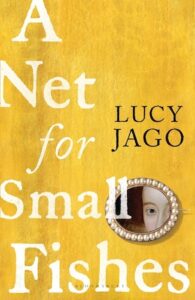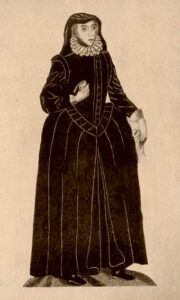Lucy Jago: Making a stink
by Mark ReynoldsLucy Jago’s A Net for Small Fishes is a captivating story of female friendship and solidarity amid a scandal that rocked the court of James I. It is narrated by 30-something Anne Turner, a doctor’s wife and mother of six with a talent for fashion and a patent for saffron dye, which she uses to dress ladies of the court with striking yellow ruffs and cuffs.
Anne is introduced to distraught teenage bride Frances Howard, who is caught in a loveless arranged marriage with the equally youthful, but vicious and overbearing Robert Devereux, Earl of Essex. With Anne’s help, Frankie makes a splash at court and is emboldened to petition for an annulment of her marriage and to forge a romantic connection with the king’s favourite Gentleman of the Bedchamber Robert Carr, who is destined to become Earl of Somerset and Lord Chamberlain.
Carr, however, is unduly influenced by poet and courtier Sir Thomas Overbury, who has a longstanding gripe against the powerful Howard family. As obstructions pile up on all fronts, and Anne’s position in society is diminished after her elderly husband’s death, the two women enlist the spiritual help of necromancer Simon Forman, the potions and prayers of cunning woman Mary Woods, and the chemical compounds of corrupt apothecary James Franklin in the hope of easing their path to happiness.
Frankie is granted the annulment and marries Carr after Overbury is banished to the Tower by the king for refusing an ambassadorship to Russia. But the connection to Franklin fuels rumours that Overbury’s subsequent death may have been the result of foul play – and Anne, Frankie and Carr are put on trial for murder by poison. History records that Anne was sent to the gallows, while both Frankie and Carr were sent to the Tower.
Full of intrigue and power play, and holding up a mirror to hierarchical society then and now, it’s a perfect read for anyone who has devoured Hilary Mantel’s Tudor trilogy and is ready for a time-shift.
Mark: Your novel has been dubbed “the Thelma and Louise of the seventeenth century”. Who first coined that, why is it a good fit, and in what ways might it mislead?
Lucy: From fairly early in the writing process, this was my elevator pitch for the book, but then Lawrence Norfolk (author of Lamprière’s Dictionary and The Pope’s Rhinoceros), also thought of it when writing about A Net for Small Fishes. I think it’s a good fit because the film takes its POV from its female protagonists – they committed a crime, but their friendship, and the challenges they faced at the hands of men, were the heart of the story. And what chaos they created! I think Anne and Frankie, while not ‘feminist’ in our sense of the word, were very much trying to push against the narrow confines of what was allowed women at the time and, in their own way, were major disrupters. It’s just an elevator pitch, not aiming at complexity, but it allows women of the seventeenth century to emerge from their farthingales and be seen for themselves.
It felt like no one, in the 400 years since the scandal, had attempted to see their point of view – not to excuse it, or whitewash events – but to take the trouble to really see it.”
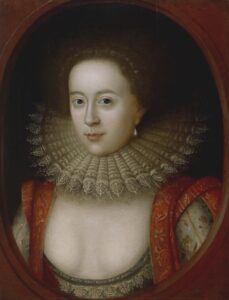
Frances, Countess of Somerset by William Larkin, c. 1615. National Portrait Gallery
You say in your author’s note that “the furore provoked by Anne and Frankie was so great that they lost all individuality and became icons co-opted by various parties to prove the villainy of villainous women, the rottenness of the English Court, the immorality of the courtier and so on.” Why did you decide to set about upturning that version of events, and “to find something that feels truthful to the known facts and to human behaviour”?
I felt they had been denied a voice. Frankie, in particular, was used as a political pawn from childhood to death and beyond. It felt like no one, in the 400 years since the scandal, had attempted to see their point of view – not to excuse it, or whitewash events – but to take the trouble to really see it.
In what ways are Anne and Frankie inspirational role models for today?
If Anne and Frankie are inspiring for some, I’m happy, but I didn’t write them to be inspirational role models, I wrote to make them real.
You acknowledge David Lindley’s The Trial of Frances Howard as an inspiration, as “a scholarly and entertaining foil to the vitriol and assumption slung at my protagonists in many other books.” Where did you turn next in your research?
There are many wonderful scholarly articles on aspects of culture and life in London at this period that I found extremely helpful – it was miraculous to me that you could find out exactly how much stockings cost new, or if redeemed from a pawn merchant, or what rules were in place in the West End’s first shopping centre (opened in 1609) to prevent urine dripping from an upper floor into the shops below or “against ye breaking of ye windows.”
I have read too many books and articles, of and on the period, to list them all, but I found particularly helpful and interesting the work of historians Linda Levy Peck, Ann Rosalind Jones and Peter Stallybrass, Alastair Bellany, Neil Cuddy, David Bergeron and Keith Thomas.
The book is prefaced by prophetic lines from Ben Jonson’s Hymenaei, a masque performed at Frankie and Essex’s wedding:
What griefs lie groaning on the nuptial bed?
What dull satiety? In what sheets of lead
Tumble and toss the restless married pair,
Each oft offended with the other’s air?
…
And to their wives men give such narrow scopes,
As if they meant to make them walk on ropes:
No tumblers bide more peril of their necks
In all their tricks; than wives in husbands’ checks.
At what point did you discover those lines and realise they make a perfect epigraph? (Surely the wedding masque as a whole can’t have been this bleak.)
I found them early on but did not use them as the epigraph until very late in the process – I thought they might be a bit off-putting! Only once I thought the book was properly working did these lines seem the right fit. Writing is a strange process sometimes. The masque was not, of course, intended to be bleak but I suspect a modern audience would find it so, for its emphasis on female obedience, chastity and silence.
The narrow alleys of pestilence and poverty run along the walls of the very richest in the land… in our current times, as the gap between rich and poor widens, there are many resonances across centuries to unearth.”
George remarks of King James’ court, “The place is a cesspit. All depravity is there, bed-hopping and syphilitic, trussed up in velvet.” And the stink of Jacobean London is established from the opening page, when Anne crosses the courtyard to Frankie’s residence and a marble fountain from which “a stench rose from the puddle in its scalloped bowl, yellow with the piss of noblemen and their dogs.” Whatever was it that appealed to you to write about these times?
It is their very stink that appeals! The narrow alleys of pestilence and poverty run along the walls of the very richest in the land… in our current times, as the gap between rich and poor widens, there are many resonances across centuries to unearth. My next book is set in the late eighteenth century, and again it will not avoid the unsavoury truth behind those lovely Georgian mansions with their Capability Brown views.
Are the pelicans we see today the only vestige of the royal menagerie at St James’s Park which, as you depict, in 1609 included antelopes, flying squirrels, two crocodiles – and an Indian? And just how extensively did King James’s silk farming operation eventually extend?
To know more about the fascinating (but tragic, usually) history of menageries in this country I recommend Caroline Grigson book, Menagerie: The History of Exotic Animals in England.
In 1609, King James wrote to his Lord Lieutenants, requesting them to plant mulberries, and offering each ten thousand trees at 3 farthings a plant or 6 shillings a hundred. He also sent silkworm eggs to the colonies in Virginia and had a Gentleman of the Bedchamber whose only job it was to carry silkworms whenever James travelled (quite why the King wanted them with him at all times I was never able to uncover). His desire to create an indigenous silk industry made sound economic sense, in that it would stop money leaving the country to purchase silk. Unfortunately, our climate is not warm enough and the industry never took off.
An episode at the high-class (or at least expensive and exclusive) brothel Holland’s Leaguer in the Paris Gardens is an eye-opener. What other such establishments were favourites among courtiers at the time?
Holland’s Leaguer was unique but there were plenty of brothels throughout the liberties (areas outside the Lord Mayor of London’s control) especially in Southwark and Bankside, near the theatres. Arrests reveal the major red-light areas to be outside the walls of the City and over the river – Clerkenwell, St Katherine’s Docks, Shoreditch, Stepney, Whitechapel and Wapping, although around St Paul’s there were plenty of brothels also.
At Anne’s first sight of the king, she remarks: “His countenance was unlovely, with drooping eyes and jowls, and his body encased in a doublet so thickly padded it resembled a turnip… it is one of God’s mysterious workings that he should raise this small man above us even while all about are men of greater strength and beauty.” Do you think we sometimes hold the great and good in too high an esteem?
No doubt, but not as much as in Anne and Frankie’s time, where every encounter was a display of deference or social superiority. Needless to say, there were plenty who refused to humble themselves – apprentices threw stinking mud at the coaches of the rich, libels were printed and fixed to posts meant only for official business as well as to church doors and ale-house walls, Quakers refused to doff their hats.
Even back then, popular broadsheets with their bawdy stories and illustrations set out to ruin reputations. Did the rumours around Frankie diminish much in her later life?
Frankie and her husband moved to Chiswick House (on the site of the present Chiswick House) and lived quietly. She was never allowed to re-enter the court and she and her husband were estranged after their séjour in the Tower. “I am dead whilst living,” she wrote. She remained the subject of gossip, even after her death.
Anne and Frankie get pulled into ever darker waters as they move on from Forman’s supposedly calling on angels for godly vengeance to Mary Woods’ “prayers to small devils and… a potion” to enlisting the help of the known poisoner Franklin. Were less reckless avenues open to Frankie, or was she just too impetuous to see them?
If you were unhappily married in 1610, there was almost nothing you could do about it. England’s divorce laws were devised before the Reformation and were more stringent in the early seventeenth century than those of many Catholic countries. The death of one’s spouse was the only way to be free of them and to remarry, otherwise you could separate from ‘bed and board’ (live apart) but not remarry. Frankie was pursuing one of the very few legal avenues available (annulment for non-consummation) although one should remember that even this course required the belief that witchcraft was responsible for the Earl’s ‘insufficiency’. It was touch and go right up to decision day whether an annulment would be granted, and so Frankie was searching for alternatives, should the annulment fail. I think it was more desperation than impetuosity.
How would King James have described his relationships with the gentlemen of his bedchamber?
Gentlemen of the Bedchamber were functionaries who served the King – it was an honour to be chosen and most of James’s were Scottish and not English, which caused great resentment amongst the English aristocracy. They served many needs, both political and physical (they ensured his clothes and jewels were kept in perfect order but many also put the requests of their petitioners to the King etc.) and were his closest companions. The King’s favourites were drawn from, or were made, Gentlemen of the Bedchamber, but the role had no sexual implication in itself.
The reader can decide whether Anne and Frankie’s actions can be justified or not. I also wanted the reader to imagine what it can have been like to see art like this for the first time.”
The title of the book derives from a comment on the fact that justice snares people of lower rank while their supposed betters go free. Was it ever thus?
The title is about ‘the King’s justice’ targeting the poor and weak, but it is also about the nets of social convention in which we are all entangled, and the consequences of trying to break free.
How closely does the book jacket resemble the cloth made using Anne Turner’s patented yellow starch?
I am not aware of any saffron-dyed ruffs and cuffs that have survived from this period (other than in art) but the jacket does have a slight feel of fine linen and the colour is certainly saffron. It is hard to judge colour in portraits of the period as the pigments of some colours fade or even change dramatically.
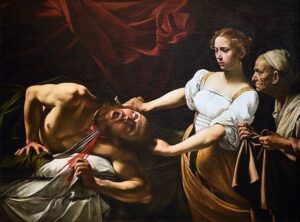
Judith Beheading Holofernes by Caravaggio, 1598–99. Galleria Nazionale d’Arte Antica, Rome/Wikimedia Commons
This is the second time this year that a painting depicting Judith and Holofernes has popped up in fiction I’ve been reading (Artemisia Gentileschi’s painting is a favourite of the protagonist in Raven Leilani’s Luster). Is it included as a comment on the different sensibilities in Italy and England, and on justifiable female vengeance? (Even Anne later declares of Italian art that “it disturbs me that the human appetite for violence and lust is so much on display.”)
The Judith Beheading Holofernes in A Net for Small Fishes is Caravaggio’s. Robert Carr’s art collection was catalogued at his arrest, and so we can have a fairly good idea of which artists he collected. Yes, I chose the subject to show a woman taking action for the defence of her people… the reader can decide whether Anne and Frankie’s actions can be similarly justified or not. I also wanted the reader to imagine what it can have been like to see art like this for the first time.
I’d love to see A Net for Small Fishes adapted for film or TV, but I suspect some of the casual cruelty toward animals would need to be toned down – I certainly wouldn’t want to see the bear-baiting scene played out in full view. What else might it be tricky to portray onscreen and why?
I would not want any production to over-emphasise the role of sexual violence or witchcraft in this story, and both topics would need extremely sensitive and intelligent handling.
During the writing, did you ever find yourself mentally casting any of the characters? Who might be ideal to play Anne and Frankie?
For some reason Geoffrey Rush kept coming to mind to play James I, but I deliberately didn’t do mental casting for Anne or Frankie because I wanted to keep them in their world, not ours.
Would you have a preference between a feature film or a TV series, and if so, why?
None at all, either would be wonderful.
What are you writing next?
A book set in the late eighteenth century about a real woman, but I can’t say more than that as it’s very early in the research stage.
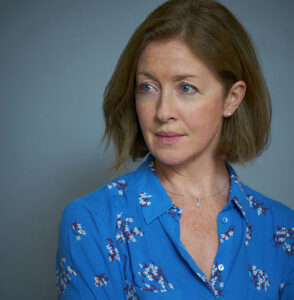 Lucy Jago is an award-winning writer of fiction and non-fiction and Fellow of the Royal Literary Fund. Her first book, The Northern Lights, won the National Biography prize and has been translated into eight languages. She was awarded a Double First Class Honours Degree from King’s College, University of Cambridge, and a master’s degree from the Courtauld Institute, London. She lives in Somerset. A Net for Small Fishes is published by Bloomsbury in hardback and eBook.
Lucy Jago is an award-winning writer of fiction and non-fiction and Fellow of the Royal Literary Fund. Her first book, The Northern Lights, won the National Biography prize and has been translated into eight languages. She was awarded a Double First Class Honours Degree from King’s College, University of Cambridge, and a master’s degree from the Courtauld Institute, London. She lives in Somerset. A Net for Small Fishes is published by Bloomsbury in hardback and eBook.
Read more
lucyjago.com
@BloomsburyBooks
Author portrait © Jonny Ring
Mark Reynolds is a freelance editor and writer, and a founding editor of Bookanista.
@bookanista
wearebookanista
bookanista.com/author/mark

